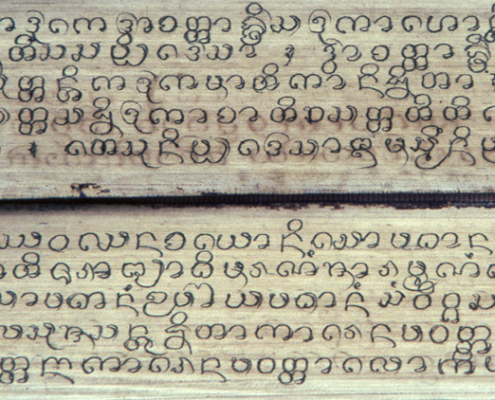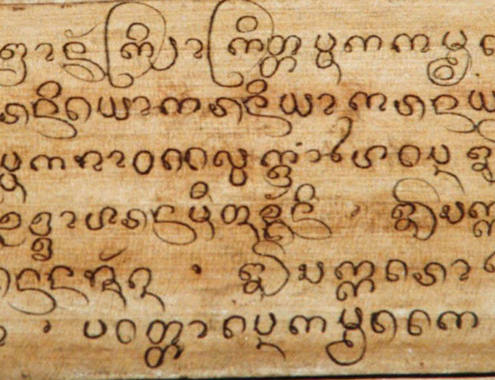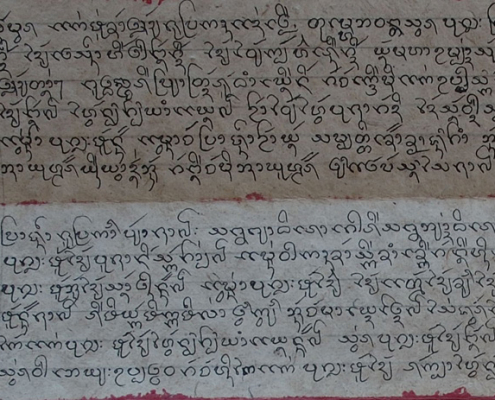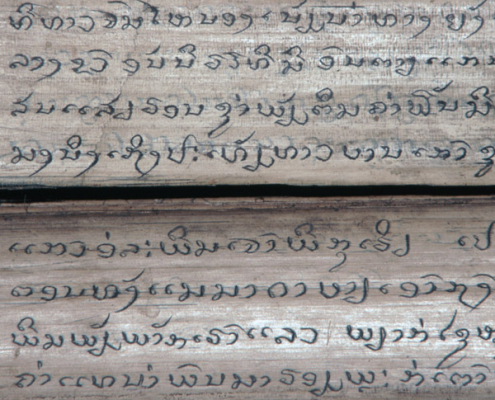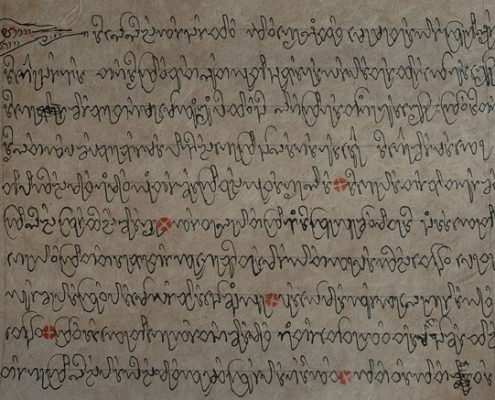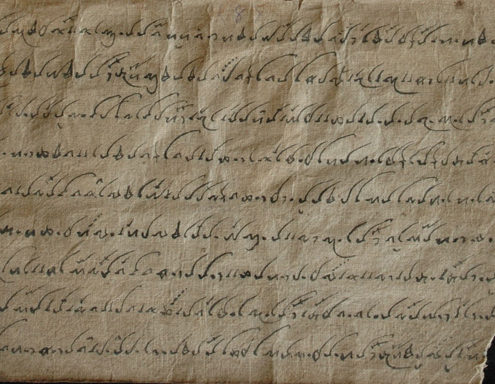Vernacular languages
The vast majority of manuscripts in the DLLM collection are in the Lao, Northern Thai, Tai Lue, and Tai Nuea languages, which belong to the Southwestern subgroup of the Tai-Kadai language family, or are bi-lingual Pali-vernacular texts. A considerable number of texts are in monolingual Pali, a small number are in Central Thai, and a single Tai Dam text is also included in the collection.
In general, each of the vernacular languages used in even the older manuscripts is understandable for contemporary speakers of that language who are familiar with the terms and idioms of traditional literature. The written languages of Lao, Northern Thai and Tai Lue are to a large extent mutually understandable, due to shared lexicon and syntax, while the pronunciation differs considerably.
See the bibliography below for related resources.
The SEAsite of the Center for Southeast Asian Studies at the University of Northern Illinois contains information, online learning resources and links related to the vernacular languages found in the DLLM collection. For Northern Thai, see the Tai Lanna section of the site. The Tai Dehong section provides a useful introduction to the Tai Nuea language as used in the Dehong Dai and Jingpo Autonomous Prefecture of Yunnan Province, China, including the Introduction to Luo Yongxian’s Dictionary of Dehong, Southwest China (see bibliography). It should be noted, however, that the Tai Dehong dialect differs from that of the Tai Nuea in Northern Laos.
The Southeast Asian Linguistics Archives contains an online searchable collection of scholarly publications on Southeast Asian languages and linguistics.
Pali
The oldest dated manuscripts from Laos and Northern Thailand, which are from the late 15th century, are in monolingual Pali. A huge number of texts containing Pali-vernacular translations, glosses, and elaborations is also to be found.
The Pali used in texts in Southeast Asia, especially Thailand, Laos and Cambodia, often diverges from the orthodox form of the language, such as laid down in Kaccāyana’s grammar. In bilingual texts, the vernacular can provide important information about local understanding or interpretation of the Pali.
‘Monolingual Pali’ was used as a manuscript category in the Preservation of Lao Manuscripts Programme to enable scholars not familiar with the vernacular languages to find monolingual texts. In the DLLM inventory, ‘Monolingual Pali’ is found under Languages, and all texts which previously had that PLMP Category (i.e. 04) have been assigned new categories.
The Pali-English Dictionary of the Pali Text Society is available online as part of the Digital South Asia Library, a project of the Center for Research Libraries and the University of Chicago.
Scripts
The majority of manuscripts in the collection are written in variants of the Tham or Dhamma script. Others are in the Lao Buhan, Lik Tai Nuea and Khom scripts, while a few remaining texts are in Central Thai and Tai Dam scripts. All of these can be traced to South Indian writing systems which were adapted for writing Pali and vernacular languages in Southeast Asia.
The Tham script shows a strong similarity to the Mon script used in inscriptions in the ancient Mon kingdom of Haripuñjaya (present-day Lamphun Province of Northern Thailand), dating from the 13th century CE. The oldest dated document using the Tham script, from CE 1376, is a bilingual inscription on a gold folio discovered in Sukhothai, containing one line of Pali language, while the vernacular is in Sukhothai Siamese language and script. The Tham script was adapted for the writing of vernacular languages not later than the 15th century CE, most probably in Chiang Mai, from where it spread to neighbouring Tai-Lao kingdoms. The oldest known dated manuscript using Tham script (not included in the DLLM collection) is a monolingual Pali copy of a section of the Jātaka-aṭṭhakathā-vaṇṇanā, from CS 833 or CE 1471, kept at Wat Lai Hin, Amphoe Ko Kha, Lampang Province, in Northern Thailand. The oldest known dated manuscript in the DLLM collection (in Tham Lao script) is a monolingual Pali copy of part of the Parivāra (PLMP Code 06018504078_00), from CS 882 or CE 1520, kept at the Provincial Museum in Luang Prabang (formerly the Royal Palace). Versions of the Tham script continue to be used to this day by the Lao, Northern Thai, Tai Lue and Tai Khuen. One can therefore refer to a ‘Tham script domain’ comprising present-day Laos, the Upper North and Northeast of Thailand, the Northeast of Myanmar, and the Southwest of Yunnan Province in China.
The Lao, Lan Na, and Tai Lue versions of the Tham script are very similar, and texts in these scripts from can be read by anyone who is literate in any one of them, and most of the contents can be understood. Characteristic features of these scripts are that the inventory of 33 consonants is in concordance with that of the Pali language, and that the second components of consonant clusters are written beneath the first. Likewise, most syllable-final consonants in vernacular texts are written beneath the preceding vowel symbol. The form of some of these subscript consonant symbols differs considerably from the standard symbol. In contrast to the Thai and Lao alphabets, the Tham script uses special ‘independent’ symbols for syllable-initial vowels in Pali texts. Another special feature is the use of various ligatures and abridged forms of certain frequently used terms. The orthography of vernacular texts written in the Tham script is much less ambiguous than, for example, that of the modern Central Thai writing system.
In Laos, the Tham script was generally reserved for religious writings, whereas texts which were considered secular were written in Lao Buhan, the precursor of the modern Lao script. A considerable number of works with identical titles are found in both Tham and Lao Buhan scripts. In most of these cases, the Lao Buhan versions are literary adaptations of religious works, intended for use by the laity. Neither Tham nor Lao Buhan scripts use tone markers, and remarkable variations in the writing of Lao Buhan add to the difficulty of reading this script.
The Tai Nuea script belongs to a group of Indic-based scripts known as lik, which are thought to date from before the 14th century CE. Related scripts are used by the Tai Nuea (Tai Le) in the Dehong region of Yunnan Province in China, and by Tai Khamti, Tai Phake, Tai Aiton, Tai Ahom, and other Tai peoples across Northern Myanmar and into Assam State of Northeastern India. Several of the consonant symbols are similar to Tham script, while others bear no clear resemblance to their Tham equivalents. In contrast to the Tham script, the very limited inventory of 16 to 18 consonant symbols indicates that these scripts were perhaps not developed for writing Pali. Even for vernacular texts, the number of consonant and vowel symbols is less than the phoneme inventory. Together with minimal written indication of tones, this makes the orthography ambiguous, with several possible readings and semantic interpretations for some written words. While the Tai Nuea manuscripts in the DLLM collection are all kept in Mueang Sing District in Northern Laos, their provenance covers a much wider area including parts of Yunnan Province in Southwestern China and Shan State in Northeastern Myanmar, from where the Tai Nuea inhabitants of Mueang Sing migrated, and there is a corresponding variety in the form of the scripts used. Many of the texts appear to be in an old form of the Lik tho ngok or ‘bean sprout’ script previously used by the Tai Mao. This differs somewhat from the old Tai Dehong script and from the reformed version of Tai Dehong script introduced in China in the mid 1950’s, which are better known examples of this type of script.
The Cambodian or Khmer script is considered to have developed from South Indian sources, but independently from the Mon script. The Khom form of this script was used for writing Buddhist texts and other treatises in Central Thailand until the early 20th century, when it was gradually replaced by Thai script. The DLLM collection contains a number of manuscripts in Pali, Lao or Thai languages, written in Khom script, from Southern Laos. Like the Tham script, it contains the full inventory of consonants in concordance with the Pali language, and uses subscript consonant symbols, as well as ‘independent’ symbols for syllable-initial vowels. Additional consonant and vowel symbols are used for writing the Thai and Lao languages. The Khom script used in Thailand is very similar to the aksar khom and aksar mul forms of modern Cambodian script which are used for titles of publications, etc. While these differ from the aksar chriang and aksar chhor styles which are used for general text in modern Cambodian publications, an understanding of modern Cambodian orthography, such as found in Huffman (1970) is still useful. Aripong (2003) provides a thorough (Thai-language) description of Khom script as used in Thailand.
Click here to see PDF versions of Lao-language primers for learning Tham Lao script:
Baep hian vai – hian an nangsue tham khian pen phasa lao
Baep hian vai – hian an nangsue tham khian pen phasa pali
Introductions to the Lao, Lanna (Northern Thai), Khmer, (Central) Thai, and Tai Dam scripts can be found in Omniglot, an online guide to the writing systems and languages of the world.
The SEAsite of the Center for Southeast Asian Studies at the University of Northern Illinois contains information, online learning resources and links related to the scripts found in the DLLM collection.
Bibliography
Ariphong_2003
Anan Ariphong, Akson khom. Songkhla: Thaksin University, BE 2546 (in Thai).
Court_1996
Court, Christopher, “The spread of Brahmi script into Southeast Asia”, in The World’s Writing Systems, (Daniels, Peter T., and William Bright, eds.). Oxford: Oxford University Press (1996): 445-449.
Diller_2008
Diller, Anthony V.N., J. A. Edmondson, and Yongxian Luo (eds.), The Tai-Kadai Languages. London: Routledge Curzon, 2008.
Enfield_2003
Enfield, N.J., Linguistic Epidemiology: semantics and grammar of language contact in mainland Southeast Asia. London: Routledge Curzon, 2003.
Enfield_2007
Enfield, N.J., A Grammar of Lao. New York: Mouton de Gruyter, 2007.
Filliozat_1992
Filliozat, Jacqueline, ‘Documents Useful for the Identification of Pāli Manuscripts of Cambodia, Laos and Thailand’ in Journal of the Pali Text Society XVI (1992): 13-54.
Gedney_1967
“Thailand and Laos,” in Linguistics in East Asia and Southeast Asia. Current Trends in Linguistics, Vol. 2 (Ed. Thomas A. Sebeok). The Hague: Walter de Gruyter Inc., (1967): 782-814.
Gedney_1976
Gedney, William J., ‘Notes on Tai Nuea’ in Tai Linguistics in Honor of Fang-Kuei Li, (Gething, Thomas W., Jimmy G. Harris, and Pranee Kullavanijaya, eds.). Bangkok: Chulalongkorn University Press (1976): 62-102.
Gedney_1994
Gedney, William J., Southwestern Tai Dialects: glossaries, texts, and translations. Michigan: Ann Arbor, 1994.
Geiger_2000
Geiger, Wilhelm, A Pali Grammar. (English transl. by Batakrishna Ghosh; revised and edited by K.R. Norman). Oxford: The Pali Text Society, 2000.
Haas_1964
Haas, Mary R., Thai-English Student’s Dictionary. Stanford: Stanford University Press, 1964.
Harris_1975
Harris, Jimmy G. ‘A comparative word list of three Tai Nüa dialects’ in Studies in Tai Linguistics in honor of William J. Gedney, (Harris, Jimmy G. & Chamberlain, James R., eds.). Bangkok: Central Institute of English Language, Office of State Universities (1975): 202-30.
Hartmann_1986a
Hartmann, John F., ‘The Spread of South Indic Scripts in Southeast Asia’ in Crossroads. 3.1 (1986): 6-20.
Hartmann_1986b
Hartmann, John F., ‘Varieties of Tai Dam Script’ in Crossroads. 3.1 (1986): 97-103.
Haudricourt_1975
Haudricourt, André-Georges, ‘Du nouveau sur le Tai Neua’ in Asie du sud-est et le monde insulindien, Vol. 6, no. 4 (1975): 163-168.
v. Hinüber_1988
von Hinüber, Oskar, ‘Die Sprachgeschichte des Pali im Spiegel der südostasiatischen Handschriftenüberlieferung’ in Abhandlung der Akademie der Wissenschaften und der Literatur, 8 (1988).
v. Hinüber_1993
von Hinüber, Oskar, ‘Pali und Lanna in den Kolophonen alter Palmblatthandschriften aus Nord-Thailand’ in G. Meiser (ed.) Indogermanica et Italica. Innsbruck: Universität Innsbruck, 1993: 223-236.
Horner_1993
Horner, I.B., Ten Jataka Stories – a pali reader. Bangkok: Mahamakut Rajavidyalaya, 1993.
Ho samut haeng chat_2004
Samnak ho samut haeng chat (krom silpakorn), Baep akson boran chabap nak rian nak sueksa. Bangkok: National Library, BE 2547 (in Thai).
Hudak_2008
Hudak, Thomas John, William J. Gedney’s Comparative Tai Source Book. Honolulu: University of Hawai’i Press, 2008.
Huffman_1970
Huffman, Franklin E., Cambodian System of Writing and Beginning Reader with Drills and Glossary. New Haven: Yale University Press, 1970.
Hundius_1990a
Hundius, Harald, Phonologie und Schrift des Nordthai. Stuttgart: Fr. Steiner Verlag – Abhandlungen für die Kunde des Morgenlandes, 48,3 (1990).
Hundius_1990b
Hundius, Harald, ‘The Colophons of Thirty Pāli Manuscripts from Northern Thailand’ in Journal of the Pali Text Society, XIV (1990): 1-173.
Kerr_1972
Kerr, Allan D., Lao-English Dictionary. Washington, DC: Catholic University of America Press, 1972.
Lafont_1962a
Lafont, Pierre-Bernard, ‘Les écritures ‘tay du Laos’ in Bulletin de l’Ecole française d’Extrême-Orient (BEFEO 50.2, 1962): 367-393.
Lafont_1962b
Lafont, Pierre-Bernard, ‘Les écritures du pāli au Laos’ in Bulletin de l’Ecole française d’Extrême-Orient (BEFEO 50.2, 1962): 395-405.
Luo_1999
Luo Yongxian, A Dictionary of Dehong, Southwest China. Canberra: Research School of Pacific and Asian Studies, Australian National University, 1999.
Maha Sena_1969a
Phaya Luang Maha Sena (Phouy), Baep hian vai – hian an nangsue tham khian pen phasa lao. Vientiane, Institut Bouddhique, 1969 (in Lao).
Maha Sena_1969b
Phaya Luang Maha Sena (Phouy), Baep hian vai – hian an nangsue tham khian pen phasa pali. Vientiane, Institut Bouddhique, 1969 (in Lao).
Mong_2004
Mong, Sai Kham, The History and Development of the Shan Scripts. Chiang Mai: Silkworm Books, 2004.
Reinhorn_1970
Reinhorn, Marc, Dictionnaire Laotien-Français. Paris: Centre de la Recherche Scientifique, 1970.
Reinhorn_1980
Reinhorn, Marc, Grammaire de la Langue Lao. Paris: Institut National des Langues et Civilisations Orientales, Université de la Sorbonne Nouvelle, 1980.
Rhys Davids_1921-25
Rhys Davids, T.W., and William Stede (eds.), Pali-English Dictionary. London: Pali Text Society, 1921-25.
Click here to access the online version at the University of Chicago.
Roongruangsri_2004
Udom Roongruangsri, Photcananukrom lanna-thai. Chiang Mai: Chiang Mai University, BE 2547 (in Thai).
Soukchaleun_1994
Mixay Soukchaleun, Baep hian an akson tham. Vientiane: Teacher Training College, 1994 (in Lao).
Suvanni_2005
Sisavoei Suvanni, Vatcananukom phasa pali-lao. Vientiane: Khongkan phatthana vatcananukom pali-lao, 2005 (in Lao).
Warder_2001
Warder, A.K., Introduction to Pali. Oxford: The Pali Text Society, 2001.
Watcharasat_2002
Bunkhit Watcharasat, Phasa lae wannakam lan na. Chiang Mai: Chulalongkorn University, BE 2545 (in Thai).
Wichienkeeo_1996
Aroonrut Wichienkeeo, The Northern Thai Dictionary of Palm-Leaf Manuscripts. Chiang Mai: Silkworm, BE 2539 (in Thai).
Wimonkasem_1991
Somchet Wimonkasem, Baep rian phasa lan na. Chiang Mai: Charoenwat, BE 2534 (in Thai).

